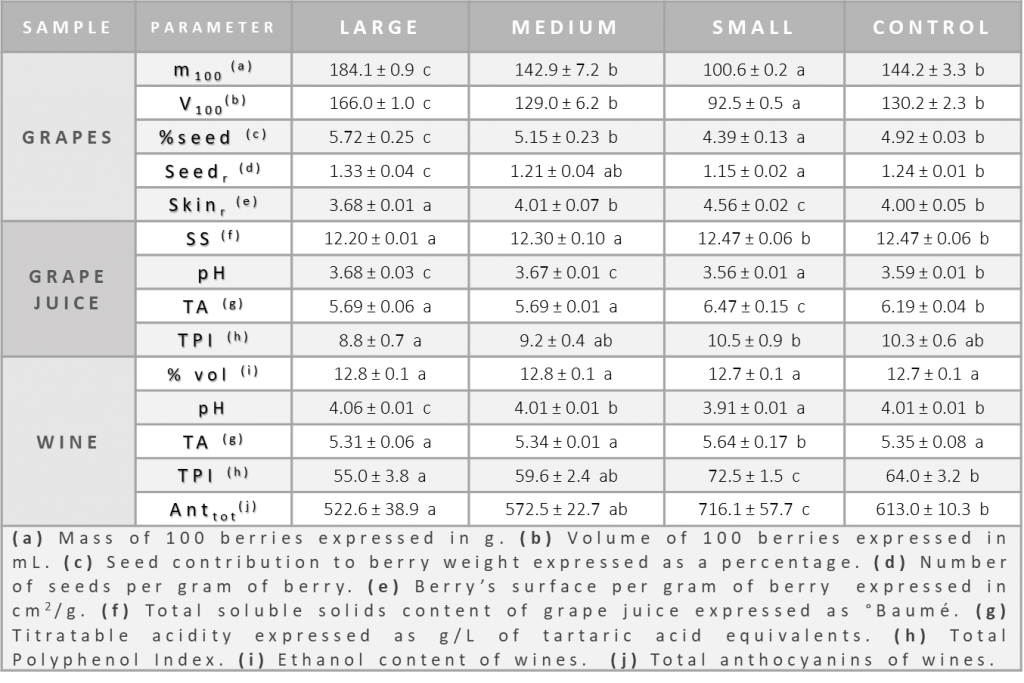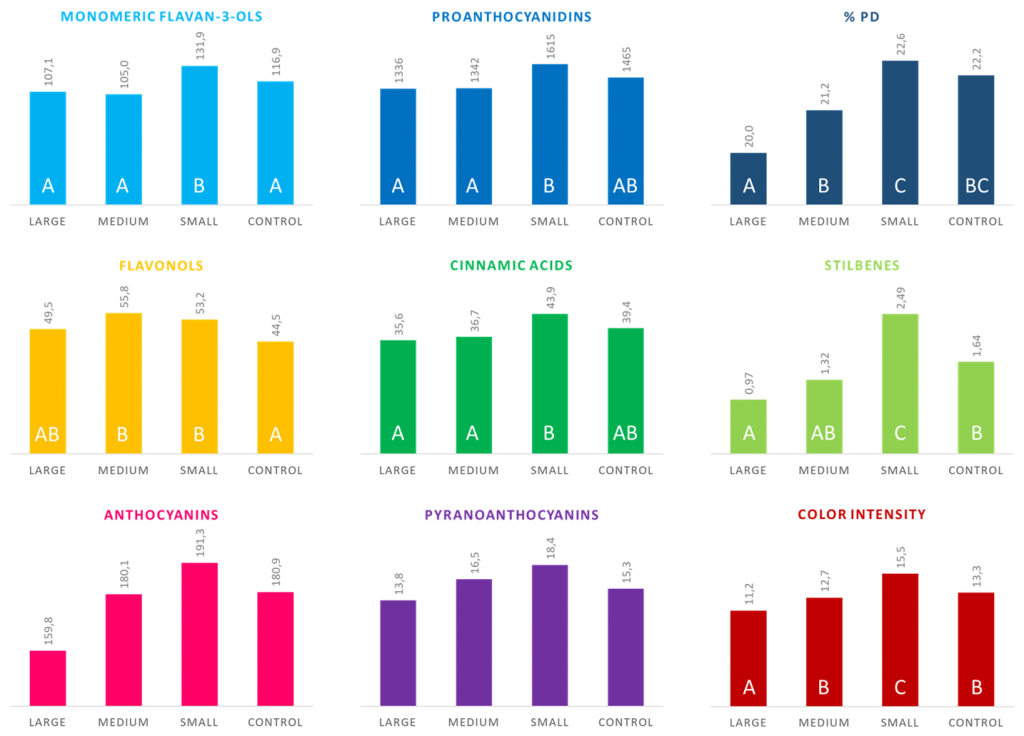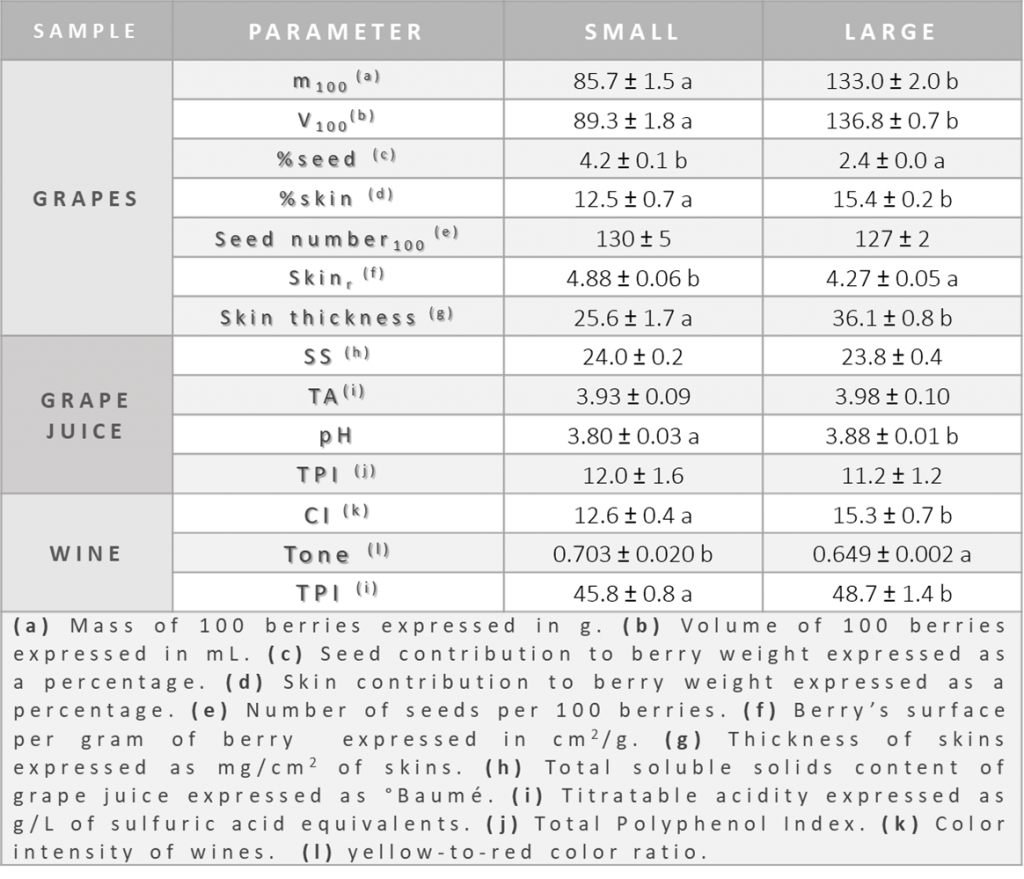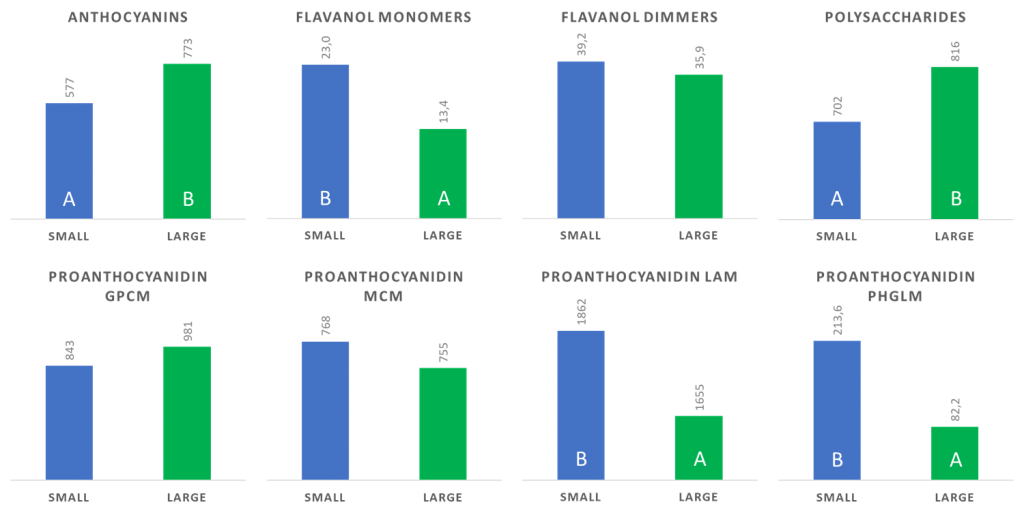By Mariona Gil i Cortiella
Red wine production is an ancient labor, and as such, it entails traditional postulates or paradigms that are not fully supported by experimental data. One of those traditional postulates is that small berries produce the best red wines. This classical postulate seems quite logical for winemakers: firstly, because the smaller and more spherical shape of wine grapes when compared with table ones, besides that some of the most appreciated red wines on the market use to come from grape cultivars with a spherical shape and small berry size (e.g. Cabernet Sauvignon cv.). Secondly, it has been demonstrated that most secondary metabolites that confer appreciable sensory attributes to wine come from grape skin tissues, while some cannot be found in the flesh (mesocarp) of grape berries: thus, if we regard grape berry shape as a perfect sphere, it can be asserted that berry surface is related to skin amount, while berry volume is related to flesh amount (regardless of seed size and number of seeds).
The study of the real impact of grape berry size on the final red wine composition is difficult, because, as reported in literature, vine’s physiology during berry development impacts the secondary metabolism of the plant along with the berry size at harvest. Thus, different approaches could be used in order to clarify the impact of berry size on the final wine composition while avoiding differences on grapevine’s physiology provoked by different conditions during the season.
The first approach we used was to screen grapes from a single vineyard by size (using a sieve) and winemaking separately every batch of sieved grapes. We performed such a trial by screening cabernet sauvignon grapes, by using two different sieves (mesh sizes 11.5 ± 0.5 mm and 14.5 ± 0.5 mm respectively) and winemaking the three resulting berry size ranges, alongside a control (unscreened grapes) winemaking trial. As could be observed in the table 1, the obtained three batches of grapes showed different berry size, but they also show differences on grape maturity, since the soluble solids (SS) content, the pH, the titratable acidity, and the phenolic index of the grape juice differs depending on grape’s size. Thus, this data indicates the heterogeneity of maturity degrees and berry sizes inside a batch of grapes from a single vineyard harvest. After winemaking, the alcohol content of wines were the same for all the wines, while the wines from the smallest grapes showed the lowest pH and the highest titratable acidity.

In general terms, a trend of phenolic content of wines was observed: the lower the berry size the higher the phenolic content. These is confirmed with total phenolic index and total anthocyanin content (table 1). Regarding the composition of the individual phenolic compounds in wines, several compounds were identified and quantified corresponding to flavonoids (monomeric flavan-3-ols, proanthocyanins -which are polymeric flavan-3-ols, also known as condensed tannins-, flavonols, and anthocyanins) and non-flavonoids (cinnamic acids and stilbenes). Among them, stilbenes, anthocyanins, flavonols, and prodelphinidins (proanthocyanins that contains flavan-3-ol monomers with trihydroxylated B-ring) could be found just in grape skins. Cinnamic acids are also present in grape flesh, and flavan-3-ols and procyanidins could also be found in grape seeds.
The total content in wines for each phenolic compound by family is shown in figure 1. Wines made with the smallest grapes showed higher concentrations of monomeric flavanols and proanthocyanins, cinnamic acids, and stilbenes. Moreover, the wines made with the smallest grapes also showed the higher color intensity and the greater proportion of prodelphinidins (% PD), which has been described as skin tannins, since they can not be found in the seeds. Thus, this results indicate that berry size impacts on the final wine composition, and that smallest grapes release a greater amount of phenolic compounds from skins to the wine than the larger ones. However, it should be noted that that differences on wine composition could be due to differences on the grape berry composition besides differences on berry size (due to grape heterogeneity at harvest).

Moreover, the wines made with the smallest grapes showed a greater content of stilbenes and monomeric flavanols than wines made with unscreened grapes (control). Thus, it seems that screening grapes by size prior to winemaking allow winemakers to obtain wines with different composition and ageing potential. As a consequence, sieve the grapes after destemming could be regarded as a tool for wine quality management in the cellar.
However, the aforementioned study do not allow to ensure that winemaking of smaller grapes lead to more concentrated reds if grapes came from different vineyards, even if they reach the same maturity degree. In order to clarify this issue, we used a second approach, by selecting two different plot-fields from the same vineyard, cultivated with plants of cv. Carménère, that show the same cultural and climatic conditions and the same ripening evolution during the season, but differs on berry size at harvest. The grapes from both plot-fields were harvested the same day, characterized, and used for red winemaking under the same conditions.
As could be observed in table 2, the grapes from both plot-fields showed statistically differences on berry size. Moreover, the largest grapes contain a higher proportion of skins and a lower proportion of seeds. Thus, the smaller grapes had a thinner skins. Despite differences on berry size and tissue distribution, both batches of grapes show the same maturity degree, regarding both technological maturity (soluble solids and titratable acidity) and phenolic maturity (total phenolic index and total anthocyanin content). As small and large grapes showed the same maturity degree but differ in berry size and tissue proportions (regarding skins, flesh, and seeds) differences on wine chemical composition could indicate the importance of these parameters on phenolic extraction during red winemaking. As could be observed in the results showed in table 2 and figure 2, the larger grapes (with a higher proportion of skins) lead to wines with deeper color and higher amount of polysaccharides, total phenolic compounds, and anthocyanins. In contrast, wines made with smaller grapes contain higher amount of monomeric flavan-3-ols (but it could be related with its higher proportion of seeds). These results seem to indicate that extraction of phenolics were more related with tissue proportion than to berry size. Regarding proanthocyanins, interesting results were obtained: by using non-hydrolytic methods (GPCM and MCM) the amount of procyanidins are almost the same for wines made from both grape sizes. In contrast, by using hydrolytic methods (LAM and PHGLM) the wines from the smaller grapes showed higher amount of procyanidins. The mismatches on procyanidin results seem to indicate that wines made from the smaller berries contain a higher proportion of “simple” condensed tannins, those conduct to quantifiable adducts after hydrolysis.

Thus, considering the presented results it could be concluded that screening grapes by size prior to winemaking could be a good tool for winemaking grape’s potential, but berry size per se could not be used as criteria for winemaking grape’s potential if grapes came from different origins, since skin’s thickness and seed’s proportion could not be neglected.

This communication contains results previously published in:
- Influence of berry size on red wine color and composition. Australian Journal of Grape and Wine Research. 21: 200-212, 2015.
- Impact of berry size at harvest on red wine composition: a winemaker’s approach. Journal of the Science of Food and Agriculture. 100: 836-845, 2020.

Dr. Mariona Gil i Cortiella is currently assistant professor in the Universidad Autónoma de Chile (Santiago de Chile, Chile), performing her research related with wine chemistry and wine technology in the Instituto de Ciencias Químicas Aplicadas, Inorganic Chemistry and Molecular Materials Center (ICQA), in collaboration with the Grupo de Investigación Enológica (GIE) of the Department of Enology and Agroindustry (University of Chile). She trained in the Universitat Rovira i Virgili (Tarragona, Spain), where she obtained a Bachelor of Science in Chemistry (2010), and a Bachelor of Science in Enology (2008), besides a Master of Science in Enology (2010), and a PhD in Enology and Biotechnology (2013). Her topics of research nowadays are related with the effect of the tanks used during winemaking on the chemical composition and sensory properties of Sauvignon blanc wines, and the characterization of cold and warm climate Syrah cv. wines from South America.


[…] For the full citation of this article, see below. Alternatively, there was an online summary of this article by one of the researchers at the Science & Wine (Ciencia & Vinho) website, which I encourage you to read for more technical details regarding the project and the results (instead of the brief summary I will provide here). That article may be found here. […]